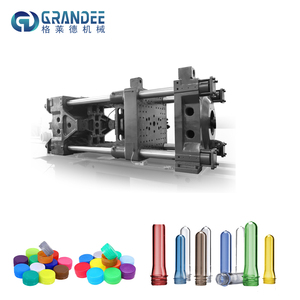
All categories
Featured selections
Trade Assurance
Buyer Central
Help Center
Get the app
Become a supplier

(2826 products available)




















































injection moulding polymers are essential parts of the manufacturing sector that help to shape raw materials into desired forms. From household goods to automobile parts, these instruments are made from plastic, metal, or other materials into precise forms to produce a range of products. Applications for injection moulding polymers abound and include blow moulding, injection moulding, and compression moulding. Their dependability and accuracy are essential for guaranteeing the consistency and quality of the end goods. The design and utility of injection moulding polymers change with technology, providing more production process adaptability and efficiency as well as more evolution.
The market features various varieties of injection moulding polymers, each intended for certain uses. Injection moulds are among the most often utilized. They are used mostly in the mass manufacture of plastic components. Two sections of these moulds create a cavity into which molten plastic is pumped. By inflating hot plastic inside a mould chamber, hollow objects, such as bottles and containers are made using blow moulds. Conversely, heat and pressure applied in compression moulds help shape thermosetting plastics. Depending on the needs of the manufacturing process, every type of injection moulding polymers presents special benefits including speed, precision, and economy.
injection moulding polymers have several purposes that are vital for the manufacturing process. They offer the framework and shape required to create consistently excellent goods. Precision engineering, durability, and material as well as production method adaptation are among injection moulding polymers main features. Essential for preserving quality standards, the accuracy of these moulds guarantees less material waste and uniform product dimensions. Modern injection moulding polymers also are made to be robust and able to tolerate the high heat and pressures of moulding operations. This durability guarantees a long lifespan and lowers the demand for regular replacements, therefore maximizing manufacturing efficiency.
Building injection moulding polymers calls for several materials selected depending on the intended use and the type of product being produced. Common materials have different qualities and include steel, aluminum, and other alloys. Because of its strength and wear resistance, steel is sometimes chosen for big-volume manufacture. For lower-volume applications and prototyping, aluminum is appropriate since it is lightweight and easier to process. The material choice affects the performance, longevity, and cost-effectiveness of the mould, so producers can customize injection moulding polymers to fit their particular requirements. Composite materials are progressively employed to improve moulding capabilities and lower environmental impact as technology develops.
Using injection moulding polymers successfully calls for a complete awareness of their capabilities and constraints. Extending the life of the mould and guaranteeing the best performance depends on proper maintenance and handling. Frequent cleaning and inspection help to guarantee moulding process precision and prevent damage. The product's material and design will help in choosing the suitable type of mould. Furthermore, cutting-edge technology such as computer-aided design (CAD) and computer-aided manufacturing (CAM) can be used to improve injection moulding polymers accuracy and efficiency. Higher quality goods and lower manufacturing costs are outcomes producers can get by streamlining these operations.
Choosing the suitable injection moulding polymers for any production line requires careful evaluation of numerous elements. Among the most crucial factors is the material intended to be handled. Different materials are needed for particular injection moulding polymers designs to guarantee the best durability and shape. For thermoplastics, injection moulds are the best; for thermosetting plastics, compression moulds are more appropriate. Achieving the intended product quality and efficiency depends on matching the injection moulding polymers type with the content.
Another important consideration in selecting injection moulding polymers design, is complexity. Complex forms and detailed elements could call for sophisticated moulding methods and precision engineering. Think about the injection moulding polymers capabilities in terms of tolerances and feature production capacity. Furthermore, the planned production volume can affect the decision since high-volume manufacturing might need sturdy materials like steel for the injection moulding polymers construction to resist frequent use.
Injection injection moulding polymers and compression moulds have diverse uses and functions. Injection moulds are appropriate for producing intricate forms and large-volume manufacturing because they allow molten material to be injected into a cavity. Conversely, typically utilized in thermosetting polymers, compression injection moulding polymers forms materials use heat and pressure. The material, degree of design complexity, and manufacturing requirements will determine which of these two to use.
Optimizing the usage of injection moulding polymers in production depends on technology. Perfect and quick mould fabrication is made possible by tools including computer-aided design (CAD) and computer-aided manufacturing (CAM). These systems can guarantee the injection moulding polymers satisfies the required criteria, replicate the moulding process, and forecast possible problems. Using these developments might help lower production costs and improve the quality of products.
Maintaining injection moulding polymers lifespan and performance depends on proper maintenance. Consistent cleaning helps to eliminate residue and stop damage. Examining the injection moulding polymers for wear and tear will assist in spotting problems early on, enabling quick repairs. Maintaining the mould's accuracy and usefulness depends partly on lubrication and calibration. Following these guidelines will help injection moulding polymers have a much longer lifetime.
Indeed, injection moulding polymers can be tailored to particular manufacturing techniques and product designs. Customizing the mould could mean changing its dimensions, form, or material to fit certain needs. This flexibility enables producers to customize injection moulding polymers to get the exact features and dimensions of products. Modern design tools help to create bespoke moulds that satisfy specified criteria.
Selecting the appropriate injection moulding polymers might be difficult given the several elements that have to be taken into account. Critical components are material compatibility, design complexity, manufacturing volume, and cost. Furthermore, future scalability and technical requirements should be considered. These difficulties call for careful investigation to make sure the chosen injection moulding polymers fits the manufacturing objectives and capabilities.